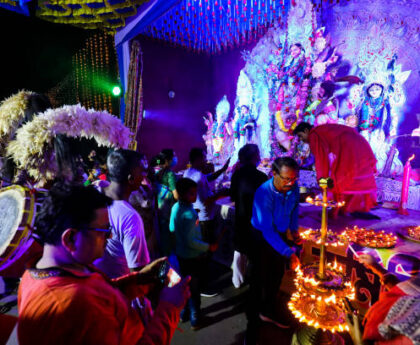
Durga Puja is one of the most significant and widely celebrated festivals in the Indian state of West Bengal. It is a major cultural and religious event that commemorates the victory of the goddess Durga over the buffalo demon Mahishasura. The history of Durga Puja in West Bengal is a rich and fascinating one, with deep-rooted traditions and a strong sense of community involvement. Here’s a brief overview:
- Ancient Origins: The worship of goddess Durga has ancient roots in India, dating back to Hindu mythology. However, the specific form of Durga Puja as it is celebrated in Bengal today has evolved over time.
- Medieval Period: The worship of Durga in Bengal can be traced back to the medieval period. Historical accounts mention the existence of Durga Puja in some form during the reign of the Pal dynasty in the 10th and 11th centuries.
- Cultural Evolution: Durga Puja evolved from a predominantly royal and aristocratic festival to a more community-based celebration over the centuries. It began to gain popularity among the common people during the Mughal period.
- 19th Century Revival: The modern Durga Puja as we know it today underwent a significant revival and transformation during the 19th century, thanks to the efforts of Raja Rammohan Roy and other social reformers. They promoted it as a symbol of Bengali culture and unity.
- British Influence: During British colonial rule, Durga Puja became a platform for expressing nationalist sentiment and cultural identity. It was also a time when large-scale community pujas began to emerge.
- Community Puja: The 19th century saw the establishment of the “Barowari” (community) Durga Puja, where people from different backgrounds pooled their resources and organized the puja. This tradition continues to be the predominant form of Durga Puja celebration in West Bengal.
- Art and Craftsmanship: Durga Puja in Bengal is not just about religious rituals; it is also a celebration of art and craftsmanship. Skilled artisans create stunning idols of the goddess and her entourage, which are displayed in elaborately decorated pandals (temporary temples). The craftsmanship involved in making these idols is legendary.
- Festive Atmosphere: Durga Puja is marked by a festive atmosphere with cultural programs, music, dance, and a wide variety of food stalls. The entire state comes alive with decorations, lighting, and colorful processions.
- Immersion: The festival concludes with the immersion of the Durga idols in rivers or water bodies, symbolizing the goddess’s return to her celestial abode. The immersion procession, known as “Vijaya Dashami” or “Bijoya Dashami,” is a grand and emotional affair.
- Modern Times: Today, Durga Puja in West Bengal has evolved into a massive event that attracts people from all over the country and even from abroad. It is not just a religious festival but a celebration of Bengali culture and heritage.
Durga Puja in West Bengal is a time of joy, unity, and reverence. It showcases the rich traditions, artistry, and community spirit of the Bengali people and continues to be an integral part of their identity and heritage.



